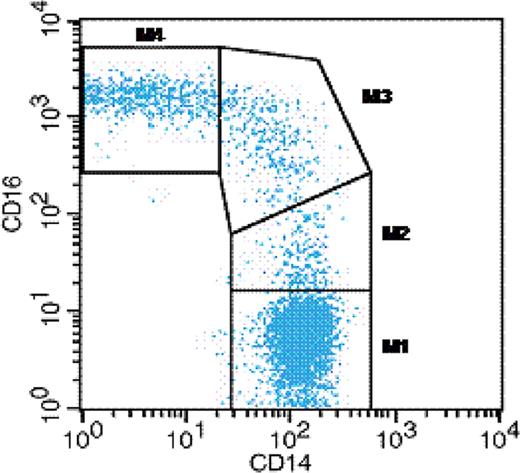Abstract
Abstract 2161
Human leukocyte antigen DR (HLA-DR) surface expression in CD14++ monocytes reflects the activation state of these cells. Decreased HLA-DR expression levels have been described as an indicator of immunosuppression. According to CD14 and CD16 expression levels, monocyte subpopulations have been classified into “classical” CD14++/CD16- (M1), “non-classical” CD14+/CD16++ (M3), “intermediate” CD14++/CD16+ (M2) and CD14-/CD16++ (M4) monocytes (Figure 1). This study analyzes HLA-DR expression in these monocyte subpopulations after hematopoietic stem cell transplantation (HSCT) and in particular during transplant-related adverse events.
30 pediatric patients (< 15 years) (n = 23) and young adults (> 15 years) (n = 7) (7 autologous, 12 allogeneic and 11 allogeneic haploidentical transplanted) with hemato-oncological malignancies and immunodeficiency disorders were consecutively included after informed written consent. Median age was 9.5 years (range 0.5–38 years). Flowcytometric assessment of HLA-DR expression was started the day before conditioning therapy and continued up to 379 days after HSCT. Normal values of HLA-DR expression in monocyte subpopulations were established from a control group of healthy children and young adults (n = 20). Surface marker expression of CD14, CD16, CD56, and HLA-DR was determined by four-color flowcytometry.
Median data acquisiton period was 228 days (range of 43–379 days). By analysis of covariance (ANCOVA), HLA-DR expression in healthy controls varied in dependency of age. In young adults (> 15 years), HLA-DR expression was significantly (P < 0.05) lower in M2, M3 and M4 but not in M1 monocyte subpopulations (P = 0.084) compared to children and adolescents (< 15 years). After HSCT, a significant decrease of HLA-DR expression in M1 and M4 monocytes was observed during sepsis or bacteremia (P < 0.01). The onset of graft-versus-host-disease (GvHD)°III-°IV was associated with a significant increase of HLA-DR expression in M1 monocytes (P < 0.05). HLA-DR expression in monocyte subpopulations was not altered before or during veno-occlusive disease (VOD), a relapse of underlying disease or before death.
The distinct HLA-DR expression pattern in monocyte subpopulations during sepsis and GvHD may facilitate identification of patients at risk after HSCT. Moreover, HLA-DR expression in monocyte subpopulations may be used to monitor treatment response in these entities.
HLA-DR expression on monocyte subpopulations
CD14++/CD16- (M1), CD14++/CD16+ (M2), CD14+/CD16++ (M3) and CD14-/CD16++(M4)
No relevant conflicts of interest to declare.
Author notes
Asterisk with author names denotes non-ASH members.


This feature is available to Subscribers Only
Sign In or Create an Account Close Modal